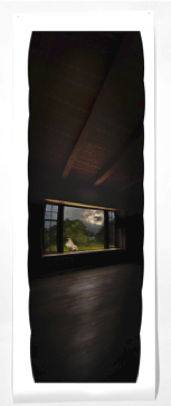Illustrating that the world is full of chance (or are they destined?) happenings:




(above, l to r) detail of hand painted (sun motif) ceiling; (below,l) photograph of living room by Mattie Edwards Hewitt 1930; June 14 commencing 5:18 AM 2006 Gissa Bu installation Godt Tegn, PS1/MOMA 2006- 2007 107” x 44” Pigment Print on Cotton Rag
All the windows (an English word that originates from the OId Norse ‘vindauga - wind’ and ‘auga - eye’)” (r) branded "Hope's Lok’d Bar” - manufactured by Henry Hope and Son.



“It‘s eerily quiet at dawns first light, and unsettling passing darkened windows of those asleep in their beds: I feel as in a dream, relying on primordial instincts, following cockeral Shinnecock with my camera, taking pictures and video.
Across the road and running up a hill of a historic estate (Note 1) on ancestral lands once owned (1930) by arts patron and Shinnecock Land Company President Samuel L. Parrish.
The land has been clearcut of trees, with Town approved plans for demolishing the Lodge (Gissa Bu) to make way for the development “Manors of Southampton”. The Developer’s website states plans for four manors: “one of a kind pieces of art. Each Villa is positioned on location for you to obtain spectacular water views from sunrise to sunset”.
My point of view has evolved from that of observer to being amongst a concerted effort with Shinnecock Indian Nation (June 2006) to preserve the 13 acres and Norwegian Lodge. And for Shinnecock I brought home three hens. The sun and moon are the subject in paintings and wood carvings throughout the Lodge - and photographs and videos in my series untitled observations. While this area is one of the oldest English Settlements in New York State, the Norwegian Lodge named “Gissa Bu” (mystery house), designed and handcrafted by Norwegians – the ancestry of MOMA/PS1 Founder Alanna Heiss who curated my “National Projects” installation “Godt Tegn”. The Lodge is a Nordic design with Viking motifs (many believe the first Europeans to travel here)... my husband’s ancestry. His name “Ulf Skogsbergh” translates to English as ‘wolf on a small mountain‘: a Mercer tile depicting a wolfman greets one’s first step inside. "Hopes Lokd Bar" is branded into each cross section of the steel framed casement windows - manufactured by the company "Hope's Windows". In one corner of a second floor room is a larger than life sized wood carving of a rooster. In another is a hen: each face windows looking east, to a rising sun and/or moon. A photo taken of this room in 1930, by renowned photographer Mattie Edwards Hewitt, reveals there was once a life size painting of a rooster courting his hen above the fireplace.
Hope Sandrow 2006
An area of animal response which bears comparison with the aesthetic sense-–is that of sexual response…to respond sexually is to want to possess sexually, whereas it has been widely held that the aesthetic sense …is content with mere contemplation. But this thought may derive from the fact that certain paradigms are used with regard to which no serious alternative to contemplation may be available-say sunsets …and though one cannot own a sunset….attempting to possess may be one form of aesthetic response. Arthur Danto. 1981

(top, ascending order) Shinnecock May 11 4:05am 2006; Shinnecock May 19 5:45am 2006; Shinnecock May 31 536 am 2006 Pigment Prints on Cotton Rag size variable
(above) Life sized wood carved Rooster and Hen (photo by Sandrow 2006) and (below) in Hewitt 1930 photo “Children’s Playroom” Gissa-Bu, hand painted figures of a hen and rooster. The Nordic Goddess Freyja, like the God Odin, is said to have flown in bird form and even on occasion to have lent her “feather form” to others.
The Tree, at the centre of the earth to join earth and heaven, being continually destroyed and yet continually renewed. In this sense it is eternal, and the implication is that while the worlds perish and the gods are slain, the tree continues through the ages, and shelters and gives birth to new life”.
-
H.R. Ellis Davidson Myths and Symbols in Pagan Europe: Early Scandinavian and Celtic Religions 1988
Note 1: Sandrow’s research, inspired by Rosanne Barons, revealed the estate built by World War I fighter pilot Lamotte Turck Cohu - a Norwegian Lodge dedicated to his wife (1930) on ancestral lands sold by arts patron and Shinnecock Land Company Samuel L. Parrish.
copyright © 2021 Hope Sandrow all rights reserved

